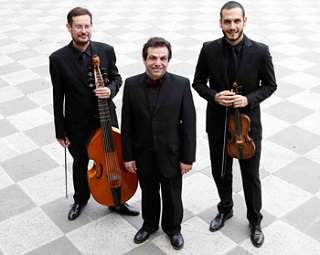|
Back
Masterpieces from the Ancien Régime: Rameau and Friends New York
The Frick Collection
02/23/2020 -
François Couperin: L’Art de toucher le clavecin: Préludes 1, 5, and 7 – Sixième ordre de clavecin: “Les Barricades mystérieuses”
Marin Marais: La Sonnerie de Sainte-Geneviève du Mont de Paris
Marin Marais/Arcangelo Corelli: Les Folies d’Espagne
Jean-Philippe Rameau: Pièces de clavecin en concerts: Premier Concert, Troisième Concert, and Cinquième Concert
Pancrace Royer: Premier livre de pièces pour clavecin: “L’Aimable” and “La Marche des Scythes”
Impetus Madrid Baroque Ensemble: Pablo Gutiérrez (violin), Jordi Comellas (viola da gamba), Yago Mahúgo (harpsichord)

Impetus Madrid Baroque Ensemble
Rameau’s 1741 collection of trio sonatas entitled Pièces de clavecin en concerts is so delightful I deeply regret that its composer gave us no other chamber music. Yet I never quite put my finger on what makes this music unique until I made my then-choir director listen to it for the first time. He—not a great Baroque enthusiast—was favorably impressed, finding it uncharacteristically melodic for the Baroque era. Now, I think it would be unfair to run too far with such a claim—what about Handel?—but Rameau does seem to have tapped in here to an expressively nuanced—and long-breathed, even rhapsodic—vein of melody that is in affect more Classical than Baroque; a touch of coyness, perhaps, alternating with the most poignant melancholy as well as unapologetic exuberance. There must have been something about the air in pre-Revolution France, for a similar strain runs through other French Baroque composers as well, yet Rameau seems exceptionally inspired here.
These works are not sonatas in the manner of Corelli, for instance, but keyboard suites with optional accompaniment. Three of them were featured this past Sunday, taking up the whole first half of the program. The lineup provided by members of the Impetus Madrid Baroque Ensemble (see above) is fairly standard in performances of this music, although Rameau also indicated a flute-and-violin accompaniment. What Sunday’s performance brought that was new to me, at least, was the chance—well, to be precise, two chances—to compare the solo and ensemble guises of this music. In both the first and third Concerts, the second movement was played twice in a row, first on harpsichord alone and then on the full ensemble. Harpsichordist Yago Mahúgo is a fine musician—the best of the group, to my ears—and so his solo forays in these movements were quite enjoyable, but each time the reprise with the accompanying strings unveiled a new level of expression. The fiddle, especially, brings a wistfulness and fancy all its own—all the more for Rameau’s avoidance (in the violin part) of too much showy virtuosity.
If anything was left to be desired, it was unfortunately in the string playing. Violinist Pablo Gutiérrez was occasionally a trifle too abrupt or staccato in his phrasing, and his tone turns scratchy rather frequently, even by gut-strung period-instrument standards. Perhaps this was exacerbated by the amazingly vivid acoustic, in itself something of a marvel. (Incidentally, there has been some talk at the Frick of getting rid of the music room, which would be villainous. It’s hard to imagine a finer venue for chamber music on either auditory or visual grounds.) Gutiérrez was most impressive in bravura passages—the famous finale of the Third Concert was dizzyingly fast—where he tended to let himself go and bring a nice sense of sweep. And Jordi Comellas on the viola da gamba had some moments of disconcertingly rough intonation. But I’m probably nitpicking here—this was a perfectly respectable, and often better than that, rendition of some of the world’s loveliest music.
After intermission, the program was rounded out with a mix of solo harpsichord music and other chamber works, all by other French Baroque composers. As to the former: as enjoyable as the Couperin works (and their realization by Mr. Mahúgo) were, the two pieces by Pancrace Royer, hitherto unknown to me, just about brought the house down: the first wonderfully droll, the second full of excitement. The Royer works just about stole the show on the second half of the program, but the trio sonatas by Marais that followed them were by no means a disappointment, and showed the returning string players in solid form. My only remaining complaint is that for an encore, we got a third hearing of the second movement of the first Rameau Concert—built upon one of Rameau’s most touching and memorable melodies, I must admit—rather than something from part of the Rameau cycle we had not previously heard!
Samuel Wigutow
|